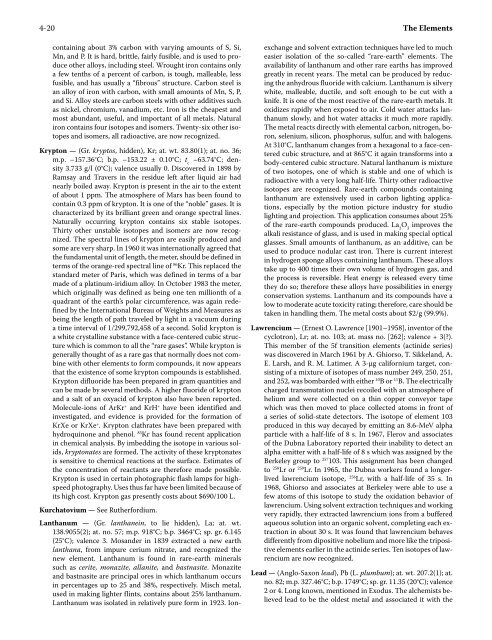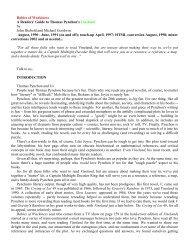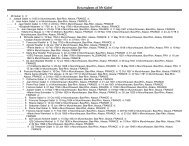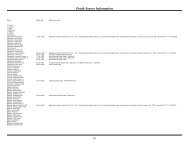CRC Handbook of Chemistry and Physics, 86th Edition
CRC Handbook of Chemistry and Physics, 86th Edition
CRC Handbook of Chemistry and Physics, 86th Edition
You also want an ePaper? Increase the reach of your titles
YUMPU automatically turns print PDFs into web optimized ePapers that Google loves.
4-20 The Elements<br />
containing about 3% carbon with varying amounts <strong>of</strong> S, Si,<br />
Mn, <strong>and</strong> P. It is hard, brittle, fairly fusible, <strong>and</strong> is used to produce<br />
other alloys, including steel. Wrought iron contains only<br />
a few tenths <strong>of</strong> a percent <strong>of</strong> carbon, is tough, malleable, less<br />
fusible, <strong>and</strong> has usually a “fibrous” structure. Carbon steel is<br />
an alloy <strong>of</strong> iron with carbon, with small amounts <strong>of</strong> Mn, S, P,<br />
<strong>and</strong> Si. Alloy steels are carbon steels with other additives such<br />
as nickel, chromium, vanadium, etc. Iron is the cheapest <strong>and</strong><br />
most abundant, useful, <strong>and</strong> important <strong>of</strong> all metals. Natural<br />
iron contains four isotopes <strong>and</strong> isomers. Twenty-six other isotopes<br />
<strong>and</strong> isomers, all radioactive, are now recognized.<br />
Krypton — (Gr. kryptos, hidden), Kr; at. wt. 83.80(1); at. no. 36;<br />
m.p. –157.36°C; b.p. –153.22 ± 0.10°C; t c –63.74°C; density<br />
3.733 g/l (0°C); valence usually 0. Discovered in 1898 by<br />
Ramsay <strong>and</strong> Travers in the residue left after liquid air had<br />
nearly boiled away. Krypton is present in the air to the extent<br />
<strong>of</strong> about 1 ppm. The atmosphere <strong>of</strong> Mars has been found to<br />
contain 0.3 ppm <strong>of</strong> krypton. It is one <strong>of</strong> the “noble” gases. It is<br />
characterized by its brilliant green <strong>and</strong> orange spectral lines.<br />
Naturally occurring krypton contains six stable isotopes.<br />
Thirty other unstable isotopes <strong>and</strong> isomers are now recognized.<br />
The spectral lines <strong>of</strong> krypton are easily produced <strong>and</strong><br />
some are very sharp. In 1960 it was internationally agreed that<br />
the fundamental unit <strong>of</strong> length, the meter, should be defined in<br />
terms <strong>of</strong> the orange-red spectral line <strong>of</strong> 86 Kr. This replaced the<br />
st<strong>and</strong>ard meter <strong>of</strong> Paris, which was defined in terms <strong>of</strong> a bar<br />
made <strong>of</strong> a platinum-iridium alloy. In October 1983 the meter,<br />
which originally was defined as being one ten millionth <strong>of</strong> a<br />
quadrant <strong>of</strong> the earth’s polar circumference, was again redefined<br />
by the International Bureau <strong>of</strong> Weights <strong>and</strong> Measures as<br />
being the length <strong>of</strong> path traveled by light in a vacuum during<br />
a time interval <strong>of</strong> 1/299,792,458 <strong>of</strong> a second. Solid krypton is<br />
a white crystalline substance with a face-centered cubic structure<br />
which is common to all the “rare gases”. While krypton is<br />
generally thought <strong>of</strong> as a rare gas that normally does not combine<br />
with other elements to form compounds, it now appears<br />
that the existence <strong>of</strong> some krypton compounds is established.<br />
Krypton difluoride has been prepared in gram quantities <strong>and</strong><br />
can be made by several methods. A higher fluoride <strong>of</strong> krypton<br />
<strong>and</strong> a salt <strong>of</strong> an oxyacid <strong>of</strong> krypton also have been reported.<br />
Molecule-ions <strong>of</strong> ArKr + <strong>and</strong> KrH + have been identified <strong>and</strong><br />
investigated, <strong>and</strong> evidence is provided for the formation <strong>of</strong><br />
KrXe or KrXe + . Krypton clathrates have been prepared with<br />
hydroquinone <strong>and</strong> phenol. 85 Kr has found recent application<br />
in chemical analysis. By imbedding the isotope in various solids,<br />
kryptonates are formed. The activity <strong>of</strong> these kryptonates<br />
is sensitive to chemical reactions at the surface. Estimates <strong>of</strong><br />
the concentration <strong>of</strong> reactants are therefore made possible.<br />
Krypton is used in certain photographic flash lamps for highspeed<br />
photography. Uses thus far have been limited because <strong>of</strong><br />
its high cost. Krypton gas presently costs about $690/100 L.<br />
Kurchatovium — See Rutherfordium.<br />
Lanthanum — (Gr. lanthanein, to lie hidden), La; at. wt.<br />
138.9055(2); at. no. 57; m.p. 918°C; b.p. 3464°C; sp. gr. 6.145<br />
(25°C); valence 3. Mos<strong>and</strong>er in 1839 extracted a new earth<br />
lanthana, from impure cerium nitrate, <strong>and</strong> recognized the<br />
new element. Lanthanum is found in rare-earth minerals<br />
such as cerite, monazite, allanite, <strong>and</strong> bastnasite. Monazite<br />
<strong>and</strong> bastnasite are principal ores in which lanthanum occurs<br />
in percentages up to 25 <strong>and</strong> 38%, respectively. Misch metal,<br />
used in making lighter flints, contains about 25% lanthanum.<br />
Lanthanum was isolated in relatively pure form in 1923. Ion-<br />
exchange <strong>and</strong> solvent extraction techniques have led to much<br />
easier isolation <strong>of</strong> the so-called “rare-earth” elements. The<br />
availability <strong>of</strong> lanthanum <strong>and</strong> other rare earths has improved<br />
greatly in recent years. The metal can be produced by reducing<br />
the anhydrous fluoride with calcium. Lanthanum is silvery<br />
white, malleable, ductile, <strong>and</strong> s<strong>of</strong>t enough to be cut with a<br />
knife. It is one <strong>of</strong> the most reactive <strong>of</strong> the rare-earth metals. It<br />
oxidizes rapidly when exposed to air. Cold water attacks lanthanum<br />
slowly, <strong>and</strong> hot water attacks it much more rapidly.<br />
The metal reacts directly with elemental carbon, nitrogen, boron,<br />
selenium, silicon, phosphorus, sulfur, <strong>and</strong> with halogens.<br />
At 310°C, lanthanum changes from a hexagonal to a face-centered<br />
cubic structure, <strong>and</strong> at 865°C it again transforms into a<br />
body-centered cubic structure. Natural lanthanum is mixture<br />
<strong>of</strong> two isotopes, one <strong>of</strong> which is stable <strong>and</strong> one <strong>of</strong> which is<br />
radioactive with a very long half-life. Thirty other radioactive<br />
isotopes are recognized. Rare-earth compounds containing<br />
lanthanum are extensively used in carbon lighting applications,<br />
especially by the motion picture industry for studio<br />
lighting <strong>and</strong> projection. This application consumes about 25%<br />
<strong>of</strong> the rare-earth compounds produced. La 2 O 3 improves the<br />
alkali resistance <strong>of</strong> glass, <strong>and</strong> is used in making special optical<br />
glasses. Small amounts <strong>of</strong> lanthanum, as an additive, can be<br />
used to produce nodular cast iron. There is current interest<br />
in hydrogen sponge alloys containing lanthanum. These alloys<br />
take up to 400 times their own volume <strong>of</strong> hydrogen gas, <strong>and</strong><br />
the process is reversible. Heat energy is released every time<br />
they do so; therefore these alloys have possibilities in energy<br />
conservation systems. Lanthanum <strong>and</strong> its compounds have a<br />
low to moderate acute toxicity rating; therefore, care should be<br />
taken in h<strong>and</strong>ling them. The metal costs about $2/g (99.9%).<br />
Lawrencium — (Ernest O. Lawrence [1901–1958], inventor <strong>of</strong> the<br />
cyclotron), Lr; at. no. 103; at. mass no. [262]; valence + 3(?).<br />
This member <strong>of</strong> the 5f transition elements (actinide series)<br />
was discovered in March 1961 by A. Ghiorso, T. Sikkel<strong>and</strong>, A.<br />
E. Larsh, <strong>and</strong> R. M. Latimer. A 3-µg californium target, consisting<br />
<strong>of</strong> a mixture <strong>of</strong> isotopes <strong>of</strong> mass number 249, 250, 251,<br />
<strong>and</strong> 252, was bombarded with either 10 B or 11 B. The electrically<br />
charged transmutation nuclei recoiled with an atmosphere <strong>of</strong><br />
helium <strong>and</strong> were collected on a thin copper conveyor tape<br />
which was then moved to place collected atoms in front <strong>of</strong><br />
a series <strong>of</strong> solid-state detectors. The isotope <strong>of</strong> element 103<br />
produced in this way decayed by emitting an 8.6-MeV alpha<br />
particle with a half-life <strong>of</strong> 8 s. In 1967, Flerov <strong>and</strong> associates<br />
<strong>of</strong> the Dubna Laboratory reported their inability to detect an<br />
alpha emitter with a half-life <strong>of</strong> 8 s which was assigned by the<br />
Berkeley group to 257 103. This assignment has been changed<br />
to 258 Lr or 259 Lr. In 1965, the Dubna workers found a longerlived<br />
lawrencium isotope, 256 Lr, with a half-life <strong>of</strong> 35 s. In<br />
1968, Ghiorso <strong>and</strong> associates at Berkeley were able to use a<br />
few atoms <strong>of</strong> this isotope to study the oxidation behavior <strong>of</strong><br />
lawrencium. Using solvent extraction techniques <strong>and</strong> working<br />
very rapidly, they extracted lawrencium ions from a buffered<br />
aqueous solution into an organic solvent, completing each extraction<br />
in about 30 s. It was found that lawrencium behaves<br />
differently from dipositive nobelium <strong>and</strong> more like the tripositive<br />
elements earlier in the actinide series. Ten isotopes <strong>of</strong> lawrencium<br />
are now recognized.<br />
Lead — (Anglo-Saxon lead), Pb (L. plumbum); at. wt. 207.2(1); at.<br />
no. 82; m.p. 327.46°C; b.p. 1749°C; sp. gr. 11.35 (20°C); valence<br />
2 or 4. Long known, mentioned in Exodus. The alchemists believed<br />
lead to be the oldest metal <strong>and</strong> associated it with the







